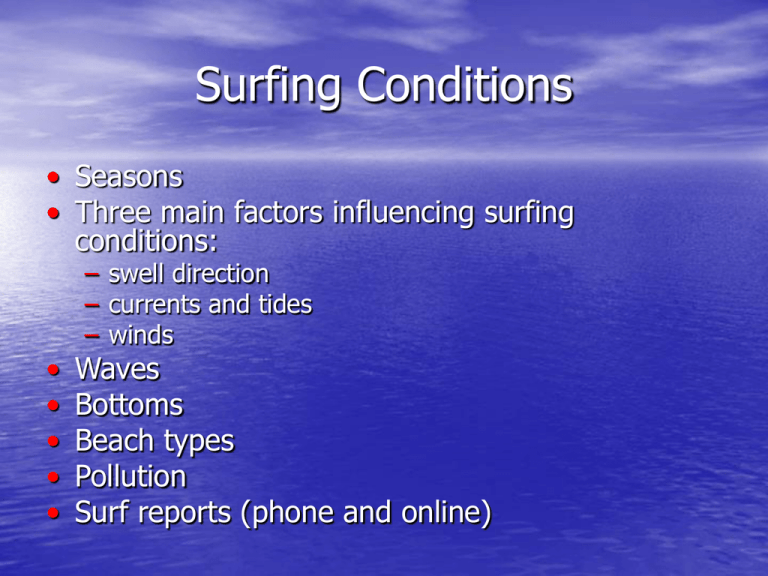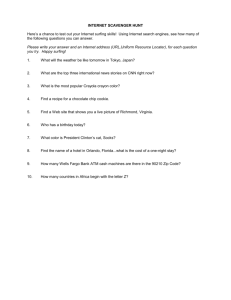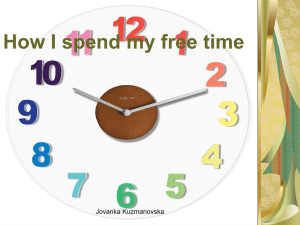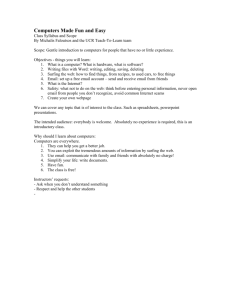Conditions
advertisement

Surfing Conditions • Seasons • Three main factors influencing surfing conditions: • • • • • – swell direction – currents and tides – winds Waves Bottoms Beach types Pollution Surf reports (phone and online) Surfing Conditions: Seasons • Conditions in California • Winter brings larger waves (often from the north and west) • Winter brings colder water (low 50’s) • Summer brings smaller, less frequent waves (often from the south) • Summer brings warmer water (up to 70˚ F) Surfing Conditions: Swell Direction North Swell West Swell South Swell Surfing Conditions: Swell Direction • North Swell: generated by storms in the North Pacific during the winter (December through February). Average size 3-6 feet, but can reach 10-15 feet (powerful). • West Swell: originates from storms in the Western Pacific and is common during fall and spring. Average size 3-6 feet. Often mixed with other swells (southwest). • South Swell: generated by storms in the South Pacific during the summer (May through September). Average size 3-6 feet but may reach 8-15 feet. The Wedge in Newport Beach reaches up to 20 feet on largest south swells. Surfing Conditions: Currents and Tides • The moon’s gravitational pull on the earth creates a bulge in the ocean, causing a high tide on the near side of the earth and on the opposite side of the earth. • The sun’s gravitational pull creates a lesser bulge in the ocean, which can contribute to or detract from the moon’s pull. • High (flow) and low (ebb) tides in California fluctuate about 4-5 feet. • In California, we have two high and two low tides (semidiurnal) in a 24-hour period. • In general, higher tides create easier-breaking waves while lower tides create faster, tubing waves (preferred). Surfing Conditions: Wind • In general, wind is bad for surfing, creating choppy, blown-out conditions. • In California, early morning is the best time to surf because the ocean’s surface is glassy and smooth. • In California, wind usually picks up by late morning, 11:00 a.m. or so. • Occasionally, the wind dies late in the day, creating “evening glass off.” Surfing Conditions: Wind Direction Sidewind moves north or south Onshore wind moves east Offshore wind moves west Surfing Conditions: Wind • One beneficial wind exists: Santa Ana wind (offshore). • Santa Ana wind is a warm, desert wind unique to southern California. • Santa Ana winds produce hollow, fast waves and occur most often in the summer. Surfing Conditions: Waves • Anatomy of a wave: crest (top), trough (bottom), face (front), peak (highest point), shoulder (side) Surfing Conditions: Measuring Waves • Waves are officially measured in feet from crest to trough. • However, surfers like to underestimate wave height or measure by back of the wave; i.e., they might call a 6-foot wave a 4-foot wave. • Surfers also often measure according to body-height: shoulderhigh, head-high, double overhead. Surfing Conditions: Bottoms • Three main types exist: sand, rock, and coral. • Sand is best for beginners and most common in California. • Rock exists at several great breaks in southern California: Rincon, Malibu, Trestles, San Onofre, etc. Booties help surfers negotiate through rocks. • Coral exists in Hawaii and other places, creating sharp and dangerous bottom. Surfing Conditions: Beach Types • Three main beach types exist. • Beach break: waves break on a sandy beach like Mondos (best for beginners) • Point break: waves break onto a rocky point like Rincon (creates a long ride with the right swell) • Reef break: waves break on a rock bed or coral reef as on many beaches in Hawaii (often creating the best and most dangerous conditions) Surfing Conditions: Pollution • Ocean water quality is determined by many factors and fluctuates but is good most of the time in California. • Some surfers avoid the ocean for a few days following rain because of the city filth washed into the ocean and the ensuing bacterial pollution. • Heal the Bay provides a weekly report card by beach and educates the public about environmental issues involving beaches. • Surfrider Foundation provides water-quality reports by beach. Surfing Conditions: Reports • Phone Reports: many city lifeguards provide a daily surf report by phone – Newport Beach (949) 673-3371 – Huntington Beach (714) 536-9303 – San Clemente (949) 492-1011 • Online Reports: several websites provide daily surf reports on the Internet – Surfline – Wavewatch – Wetsand Surfing Conditions: Resources • The Encyclopedia of Surfing by Matt Warshaw • Surfing California by Bank Wright • The WetSand WaveCast® Guide to Surf Forecasting by Nathan Todd Cool The End • Return to KPEA 109



